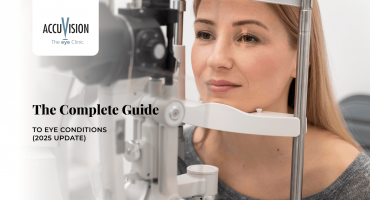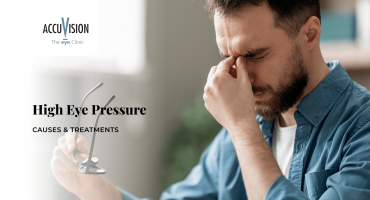- What Exactly Is a Subconjunctival Hemorrhage?
- Common Causes of a Popped Blood Vessel in the Eye
- Symptoms and How It Looks & Feels
- When to See a Doctor
- Blood Clot in Eye Treatment Options: What Can Be Done
- Preventing Future Eye Bleeds
- Conclusion
- FAQs:
Bleeding On The White Of The Eye: Causes, Symptoms, And Treatment Options

Discovering a bright red patch in your eye can be quite alarming. When you look in the mirror and notice what appears to be a blood clot in the eye, your first instinct might be concern or even panic. The term “blood clot in the eye” can actually refer to different conditions. In some cases, it describes a minor and harmless subconjunctival hemorrhage, which occurs when a tiny blood vessel breaks beneath the clear surface of the eye, leaving a bright red patch on the white part. In other cases, it may refer to a more serious problem such as a retinal vascular occlusion, where a blood clot blocks a vessel supplying the retina. This can cause blurry vision, vision loss, and requires immediate medical attention.
In this article, we will focus on the subconjunctival hemorrhage, which is the more common and usually harmless cause of eye bleeding. While the sight of blood in the white of the eye can look dramatic, the condition often resolves on its own without treatment. However, understanding what causes it, how to recognize the symptoms, and when to seek medical attention is important for protecting your eye health.
If you notice bleeding or a red patch on the white of your eye, it’s important to seek evaluation from a qualified eye care professional. This article provides general information to help you understand possible causes, symptoms, and treatment options.
If you’re experiencing eye redness or bleeding, book a comprehensive eye examination at AccuVision to ensure your eyes are healthy and rule out any underlying conditions.
What Exactly Is a Subconjunctival Hemorrhage?
Although people often call it a blood clot in the eye, this isn’t a true clot like those that form in veins or arteries. Instead, it’s a small pocket of blood trapped under the conjunctiva, the clear membrane covering the white part of the eye.
A subconjunctival hemorrhage occurs when a small, broken blood vessel in the eye leaks blood beneath the conjunctiva, the transparent membrane covering the white part of your eye.
The sclera is the tough, white outer layer of your eyeball that provides structure and protection. Covering the sclera is the conjunctiva, a thin, clear membrane that acts like a protective film. The conjunctiva is so transparent that the white sclera beneath it remains clearly visible.
The conjunctiva contains numerous tiny, fragile blood vessels that supply it with oxygen and nutrients. When one of these delicate vessels ruptures, blood leaks out and becomes trapped in the space between the conjunctiva and the sclera. Think of it like a blister, but instead of clear fluid collecting under the skin, blood collects under the transparent conjunctiva.
Despite its appearance, this is not actually a clot in the traditional sense, like those that form in veins or arteries throughout the body. Instead, it represents pooled blood that has seeped into this space. Because the conjunctiva remains transparent, the bright red blood becomes highly visible against the white sclera, creating a vivid red patch on the white part of the eye. The blood cannot be rinsed or wiped away because it sits beneath the surface layer, trapped between these two structures until your body naturally reabsorbs it.
For general information about eye anatomy and related conditions, visit the AccuVision Eye Health & Vision Blog.
Common Causes of a Popped Blood Vessel in the Eye
A popped blood vessel in the eye can result from various factors, ranging from everyday activities to underlying health conditions. Understanding these causes helps you identify potential triggers and take preventive measures.
Physical strain:
One of the most common culprits. Forceful coughing, violent sneezing, or severe vomiting can create sudden pressure that ruptures delicate eye blood vessels. Similarly, heavy lifting or straining during bowel movements can produce the same effect.
Eye trauma:
Rubbing your eyes too vigorously, even when they feel itchy or worn out, can damage the fragile vessels. Direct injury from accidents, sports, or foreign objects can also lead to bleeding.
Medical conditions:
Because high blood pressure (hypertension) is a common underlying factor, your eye specialist may recommend a general health check to monitor your blood pressure and overall vascular health.
Medications:
Those that affect blood clotting, such as aspirin, warfarin, or other anticoagulants, can make blood vessels more prone to bleeding. Even some herbal supplements like ginkgo biloba may have blood-thinning effects.
Eye procedures & Lens Irritations
Recent laser eye surgery, particularly cataract operations or other surgical interventions, can cause temporary bleeding. Contact lens irritation from improper use or ill-fitting lenses may also contribute to vessel rupture.
Interestingly, a popped blood vessel in the eye sometimes occurs spontaneously without any identifiable cause, particularly in older adults whose blood vessels become more fragile with age.
Symptoms and How It Looks & Feels
The most obvious sign of a subconjunctival hemorrhage is a bright red spot in the eye that appears suddenly, often noticed first thing in the morning. Typical symptoms include:
- A bright red patch on the white part of your eye that may be small and localized or spread across a larger area.
- No pain or discomfort in most cases.
- Vision remains completely normal with no blurriness, distortion, or loss of visual field.
- No discharge, excessive tearing, or sensitivity to light.
- Possible mild scratchy sensation or feeling of fullness in the affected eye, similar to having a grain of sand present.
- The red colour typically fades gradually to orange, then yellow, before disappearing completely as the blood is
reabsorbed.
If you notice pain, swelling, or blurry vision, seek professional evaluation immediately at your nearest AccuVision Eye Clinic
When to See a Doctor
Even though most subconjunctival hemorrhages resolve on their own, it’s important to have your eyes checked by an eye care professional to ensure there are no underlying concerns. A quick examination can confirm that the bleed has clear boundaries, the internal eye is healthy, and your vision remains unaffected. Recognizing these warning signs ensures that potentially serious conditions receive adequate attention.
- Recurrent bleeding: If you experience repeated episodes of broken blood vessels in your eyes, an underlying cause such
as high blood pressure, diabetes, or a bleeding disorder may require treatment. Your eye specialist can conduct comprehensive testing to identify contributing factors. - Accompanying symptoms: Pain, discharge, significant swelling, vision changes, or light sensitivity alongside the bleeding suggest a different, potentially serious condition that requires immediate assessment.
- Trauma-related bleeding: If the subconjunctival hemorrhage follows an eye injury, accident, or blow to the head, examination is essential to rule out more extensive damage to internal eye structures.
- Medication considerations: Those taking anticoagulants or with known bleeding disorders should be cautious. While subconjunctival hemorrhages in these patients often remain non-concerning, a medical review ensures proper medication management and rules out systemic bleeding issues.
Blood Clot in Eye Treatment Options: What Can Be Done
The good news about subconjunctival hemorrhage is that blood clot in eye treatment typically requires no medical intervention. The condition resolves spontaneously as your body naturally reabsorbs the trapped blood, usually within one to two weeks. Larger hemorrhages may take slightly longer to clear completely.
No specific medications or procedures can accelerate the healing process. The blood must simply be reabsorbed naturally, much like a bruise on your skin gradually fades. However, several measures can provide comfort and support healing.
- Lubricating eye drops: These can relieve any mild scratchiness or irritation you might experience. Over-the-counter
products are safe to use several times daily and help keep the eye surface comfortable. - Avoiding further strain: Prevent additional bleeding or enlargement of the existing hemorrhage by refraining from heavy
lifting, straining, or vigorous eye rubbing during the healing period. If you wear contact lenses, consider switching to glasses temporarily to reduce potential irritation. - Cold compresses: Applying a gentle cold compress to the closed eyelid during the first 24 hours may help if any swelling
is present, though this is uncommon with simple subconjunctival hemorrhages.
While the condition usually heals naturally, a professional eye examination is still advisable to rule out other issues and provide reassurance. If an underlying cause is identified, such as uncontrolled high blood pressure, treating that condition becomes the priority. Your doctor may adjust medications, recommend lifestyle modifications, or suggest additional testing to address contributing factors.
Preventing Future Eye Bleeds
Although we cannot prevent all subconjunctival hemorrhages, we can implement several strategies that lower the likelihood of future episodes.
Managing chronic conditions:
Keep blood pressure within recommended ranges through medication, diet, and exercise. Maintain good control of diabetes with regular monitoring and appropriate treatment. These measures protect blood vessel health throughout your body, including your eyes.
Gentle eye care:
Avoid rubbing your eyes vigorously, even when they feel itchy. If you must touch your eyes, do so gently and with clean hands. Remove contact lenses carefully and follow proper hygiene protocols.
Protective eyewear:
Prevent trauma-related hemorrhages by wearing appropriate safety glasses during activities that pose eye injury risks, including certain sports and occupational tasks.
Medication monitoring:
If you are taking blood thinners, work closely with your doctor to ensure your anticoagulant dosage remains appropriate. Never adjust or discontinue these medications without medical guidance, as they serve important health purposes.
Regular eye examinations:
Routine eye check-ups allow early detection of conditions that might predispose you to eye bleeding. Comprehensive eye health assessments identify issues before they cause problems, supporting long-term vision wellness.
Conclusion
According to the NHS Foundation Trust, while discovering bleeding on the white of your eye can look dramatic and concerning, most cases of subconjunctival haemorrhage are harmless and resolve on their own. Still, an eye check-up is recommended to confirm everything is normal and to identify any contributing health factors such as high blood pressure. Subconjunctival haemorrhages are common and resolve naturally without lasting effects. The dramatic appearance rarely reflects the actual severity of the condition.
However, prompt professional evaluation offers valuable reassurance and guarantees the exclusion of more serious causes when necessary. Your eyes are precious, and any concerns about their health deserve proper attention.
This article was prepared by the clinical team at AccuVision Eye Clinic, a trusted UK-based centre for laser eye surgery and comprehensive vision correction. With expert ophthalmologists and optometrists across the UK, AccuVision ensures that every article reflects accurate, medically reviewed information and promotes evidence-based eye health awareness.
FAQs:
1. What causes bleeding or a red patch on the white of the eye?
Usually, a subconjunctival haemorrhage occurs from minor strain, coughing, or trauma.
2. What is a broken blood vessel in the eye?
A tiny vessel ruptured under the conjunctiva, causing a visible red patch.
3. How is subconjunctival haemorrhage (bleeding on the white of the eye) treated?
Most cases heal on their own in 1–2 weeks; drops and rest can help.
4. Can a popped blood vessel in the eye affect vision?
Rarely. Vision is usually unaffected, and the eye heals naturally.
5. When should I see a doctor for blood in the white part of the eye?
If bleeding is recurrent, large, or comes with pain, swelling, or vision changes.
References:
University Hospital Southampton NHS Foundation Trust (2019) Subconjunctival haemorrhage: patient information factsheet. Version 1, reviewed May 2019. Available at:
https://www.uhs.nhs.uk/Media/UHS-website-2019/Patientinformation/Eyes/Subconjunctival-haemorrhage-1389-PIL.pdf








